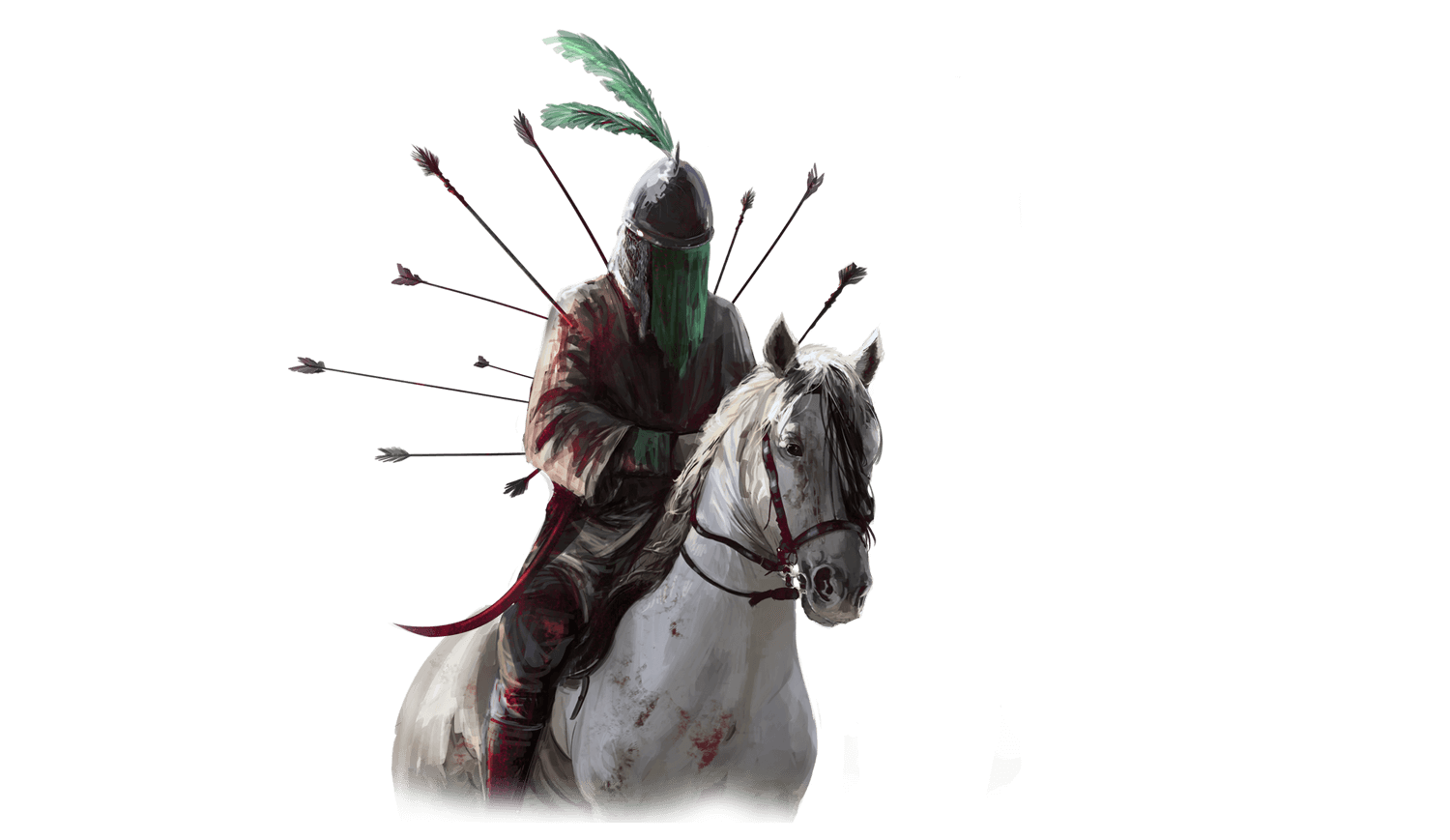Imam Hossein (AS) knew that he only had two choices, either pay allegiance to Yazid, or be killed. The Imam had said, “Even if I hide inside a hole, they will finally find me and kill me if I don’t pay allegiance.” However, the Imam knew that his allegiance would legitimize Yazid as a leader, as well as the Islam propagated by Muawiyah and the Umayyads. Therefore, the Imam pursued the second choice, and sacrificed everything he had for the sake of God and the awakening of the Prophet’s nation. He was martyred in an unprecedented, horrifying, and brutal way, where his family and companions were martyred thirsty, his six month old baby slayed, his head slaughtered, his belongings looted, his ring finger cut off, his body trampled, his family imprisoned, all in the holy month of Muharram, when war and bloodshed was strictly forbidden (Haram) in Islam.
Imam Hossein
The Prophet's Nation's Awakener


Imam's Age
Birth
Imam Hossein (AS) was born on the 3rd of Sha’ban in the 4th year of Hijri in Medina. He was the second child of Imam Ali (AS) and Lady Fatimah (SA) after Imam Hasan (AS), and the second grandchild of the Prophet Muhammad (PBUH). After his birth, the angel Gabriel came to the Prophet and said, “O’ Prophet, Ali to you is like Haroon was to Musa, so name this child the name of Haroon’s younger son, Shubair, which in Arabic is Hossein.” After the Holy Prophet whispered the Azan in the baby’s ears, he had tears in his eyes. He said, “This child will be killed by a group of rebellious and cruel men to whom God has forbidden my intercession (shifa’at).” The Prophet also performed similar traditions for the newborn as he did for Imam Hasan, such as sacrificing two animals, shaving the baby’s head, and paying silver equivalent to the weight of the baby’s hair to charity.
With his Grandfather, the Holy Prophet
The Holy Prophet had a special place in his heart for both of his grandsons, Imam Hasan and Imam Hossein, who are, according to the verse of Tat-heer (Purification) [33:33], a part of his household, and are purified. The Prophet encouraged all of the believers to love and respect his household as the verse [42:23] from the Holy Quran states, “I do not ask you for any reward except love for (my) kin.” The Prophet said, “Hasan and Hossein are the leaders of the youth of Paradise” and are Imams whether they are sitting or standing, implying whether they are at peace, or at war against injustice. The Prophet also said, “Hossein is from me and I am from Hossein.”
Mubahilah (Cursing of the Untruthful)
The Christians of Najran refused to accept Islam after discussing Christianity with the Holy Prophet but were willing to do Mubahilah or cursing of the untruthful. To the surprise of the Christians, the Holy Prophet did not bring an army or his companions. Instead, he brought his family, Imam Ali, Lady Fatimah, Imam Hasan, and Imam Hossein. After seeing the Prophet’s family, the Christians felt discouraged from doing Mubahilah. The verse of the Mubahilah [3:61] was then revealed, calling Imam Hasan and Imam Hossein the sons of the Holy Prophet.
Martyrdom of Lady Fatimah (SA)
Lady Fatimah (SA), the only surviving daughter of the Holy Prophet, was martyred within a few months after the demise of the Holy Prophet. The attack on her house in an attempt to forcefully gain allegiance from Imam Ali for the first caliph left Lady Fatimah fatally injured, causing the miscarriage of her baby and her eventual passing. Imam Hasan and Imam Hossein witnessed this injustice and were present at the secret burial of their mother at night.
Caliphate of Imam Ali (AS)
Imam Hossein always accompanied his father during his caliphate and supported him in all circumstances. Imam Hossein was a brave and courageous warrior in the Battles of Jamal, Siffin, and Nahrawan. He also advised and delivered wise speeches on many occasions, and encouraged people to join the war and to support his father.
Caliphate of Imam Hasan (AS)
When Imam Hasan became the caliph, Imam Hossein paid allegiance to his brother. He was Imam Hasan’s right hand during the short caliphate that lasted less than seven months. Imam Hossein had a key role in the preparation of the army, and was with his brother when they moved to Madain for the war against Muawiyah.
When Imam Hasan had to accept the peace treaty with Muawiyah due to lack of support from his army, Imam Hossein obeyed his brother’s decision and accepted the peace treaty. Imam Hossein refused a group of Shia followers who asked him to wage war against Muawiyah, and notified them of his adherence to his brother’s decision. After the peace treaty with Muawiyah, Imam Hasan and Imam Hossein returned to Medina.
Martyrdom of Imam Hasan (AS)
On the first day as an Imam, Imam Hossein faced a challenge during the burial of his brother. Marwan ibn al-Hakam and his troops, with support from Aisha, one of the Prophet’s wives, did not allow Imam Hasan’s body to get close to the Prophet’s tomb. In the conflict between the people and the troops, many arrows were fired towards Imam Hasan’s body. Imam Hossein controlled the situation and directed the crowd towards the Baqi’ cemetery by reminding them of Imam Hasan’s will.
Resistance Against Muawiyah
The conflict during Imam Hasan’s burial was a strong message to Imam Hossein from the Umayyads, that in case of any opposition, he would be faced with their swords. During Muawiyah’s time, Imam Hossein’s life and activities were under intense pressure and surveillance by the government to the extent that even his supporters were sometimes prevented from meeting him freely. Due to this pressure, the number of narrations quoted from Imam Hasan and Imam Hossein during Muawiyah’s time are fewer than those from the other Shia Imams.
Imam Hossein continued his brother’s policy regarding Muawiyah for around 10 years until Muawiyah’s death. When the Imam’s Shia followers from Kufa contacted him shortly after Imam Hasan’s martyrdom and asked for his uprising against the injustices of Muawiyah, the Imam reminded them about his commitment to the peace treaty and asked them to wait until Muawiyah’s death. If the Imam would have risen in Muawiyah’s time, Muawiyah would have killed the Imam and accused him of violating the peace treaty. As a result, the Imam’s death would have been misinterpreted by the Muslim community.
Allegiance for Yazid
After years of being in power, Muawiyah decided to keep the government within the Umayyads by passing it to his only son, Yazid. For the first time since the Prophet’s demise, Muawiyah intended to change the system of government from a caliphate to a monarchy. Muawiyah himself knew that Yazid lacked public popularity as he did not even keep an Islamic outlook in life like himself. Yazid publicly drank alcohol, womanized, and indulged in sinful behavior.
After years of planning, he finally succeeded in accumulating allegiances from people all around the Islamic territory. However, Imam Hossein refused to pledge allegiance. Muawiyah sent a letter to Imam Hossein, to which the Imam responded by condemning his actions to coerce allegiance for a successor, especially for someone like Yazid. Muawiyah then decided to personally visit Medina and made a public speech in which he spoke highly of Yazid to encourage the people to pledge allegiance to him. Imam Hossein interrupted the speech and disqualified Yazid, rejecting allegiance to someone of his character. Thus, Imam Hossein remained Yazid’s primary opposition.
Yazid in Power
After Muawiyah’s death, his son, Yazid, came into power. Yazid sent letters to his governors, asking them to announce Muawiyah’s death and demand allegiance from the people on his behalf. He sent an additional letter to Medina, in which he ordered his governor, Valeed, to demand immediate allegiance for him from Imam Hossein before the news of Muawiyah’s death spread in the city. Yazid explicitly asked Valeed to either get the Imam’s allegiance, or to send the Imam’s severed head to him.
Migration to Mecca
Imam Hossein knew that Medina was no longer safe for him, as Yazid would take drastic measures to eliminate him. The Imam did not want his death to be forgotten silently similar to the injustice that happened to Imam Hasan. Thus, the Imam decided to leave Medina, and migrated to Mecca in less than three days after his meeting with Valeed. The Imam decided to migrate with his family, as it was very likely that the government would imprison them as hostages to pressurize the Imam for allegiance.
The Imam in Mecca
While in Mecca, the Imam was visited day and night by many pilgrims who had come to Mecca for Umrah and Hajj. The Imam spoke to them about his intention for uprising against Yazid. When the people of Kufa found out that the Imam had not paid allegiance to Yazid and had migrated to Mecca, they decided to invite the Imam to Kufa, and pledged to support his uprising against Yazid. A flood of letters arrived to the Imam from Kufa. In just one day, the Imam received around 600 letters from Kufa, with a total of about 12,000 letters. The Imam had many Shia followers in Kufa and they had more political freedom. Kufa was a bigger city than Mecca or Medina, with a larger population and potential for troops. It was the main center of opposition to the Umayyads since the caliphate of Imam Ali. Thus, the Imam sent his cousin, Muslim ibn Aqeel, to investigate whether the Kufans were sincere in their intentions.
The Imam Towards Kufa
After receiving the letter from Muslim, the Imam left Mecca in the darkness of dawn on the 8th of the month of Zu al-Hijjah, one day before the Hajj pilgrimage started. This day coincided with the day of Muslim’s uprising and defeat in Kufa. The Imam left Mecca as he verified news that Yazid was planning his assassination while the pilgrims would be performing Hajj, and would not be carrying any weapons. The Imam did not want his blood to be shed in the vicinity of the Holy Ka’ba due to the sanctity of the holy site. The Imam told some people that he preferred that his blood be shed outside, as opposed to inside the holy site’s vicinity. Thus, the Imam left Mecca after staying there for four months and five days.
The Imam had traveled most of the way towards Kufa, where he was confronted by a Kufan army of about 1,000 horse riders under the leadership of Hurr with orders to arrest the Imam. The Imam resisted, and decided to return to Medina since he was left with no choice. Hurr opposed him, and stated his orders were to not leave the Imam alone under any circumstances. He told the Imam that he did not have an order for war, and gave the Imam two choices, to surrender and come with him to Kufa before Ibn Ziyad, the Yazid’s governor, or to go somewhere other than Kufa and Medina. Thus, the Imam had to redirect his caravan away from Kufa.
The Imam in Karbala
After a few days, Hurr received a letter from Ibn Ziyad in which he ordered Hurr to stop the Imam in the desert away from any residential areas. Therefore, on the second day of Muharram, the Imam entered the land of Karbala. Some of the Imam’s companions suggested starting a war with the army of Hurr before any reinforcements joined him, but the Imam declined, as he did not want to initiate the war.
On the third day of Muharram, Umar ibn Sa’ad arrived in Karbala with 4,000 troops, and took away the leadership of the Kufan army from Hurr. Umar ibn Sa’ad was hesitant to come to Karbala, but Ibn Ziyad threatened his candidacy for governorship of Rey in Iran so he accepted. The Kufan army was arriving by the thousands each day. By the sixth day of Muharram, the Kufan army was complete at around 22,000 to 35,000 soldiers.
Over several days, the Imam held a few meetings with Umar ibn Sa’ad, during which he tried to warn him to avoid bloodshed and allow the Imam to return. Umar ibn Sa’ad wrote a letter to Ibn Ziyad and encouraged him to accept the Imam’s offer.
Ibn Ziyad ordered Umar ibn Sa’ad to block access to the water from the Euphrates River to put more pressure on the Imam to pay allegiance. Thus, by the beginning of the seventh day of Muharram, the Imam did not have access to water.
On the ninth day of Muharram, Umar ibn Sa’ad received a letter from Ibn Ziyad, denying his proposal to avoid a war and threatening to replace him with Shimr if he failed to finish the Imam. Ibn Ziyad also asked Umar ibn Sa’ad explicitly to trample the Imam’s body after his victory. Thus, after the afternoon prayers, Umar ibn Sa’ad prepared his army for war, where the Imam sent his brother, Abbas, to postpone the war until the next day’s morning. Umar ibn Sa’ad accepted with hopes that the Imam would surrender.
Tenth of Muharram (the Day of Ashura)
On the morning of Ashura, the tenth day of Muharram in the year 61 Hijri, after the morning prayers, the Imam prepared his thirsty army of 72 companions, which consisted of 40 soldiers on foot and 32 on horses. The Imam then ordered the trench behind the tents to be put on fire so that the enemy could not attack them from behind.
The Imam spoke to the Kufan army, reminding them that he was the grandson of the Prophet, and was very dear to him. He told them that he had arrived because of their invitations. He told them that if they did not want him in Kufa, he would go back to somewhere safe. The Imam also asked them if anyone wanted to join him.
Hurr, the army leader who had first confronted the Imam, was amongst the very few people who was touched by the Imam’s words and decided to switch sides and joined the Imam. Hurr repented and requested to be sent to the battlefield immediately. The Imam accepted Hurr’s repentance and allowed him to go into the battlefield.
Umar ibn Sa’ad was the first person to start the battle by firing an arrow. He asked his army to witness for Ibn Ziyad that he had initiated the war. His troops followed by firing thousands of arrows and then invaded the Imam’s army. By that time, up to around 50 of the Imam’s companions, a large fraction of his army, were martyred. No one from the Imam’s companions were left without an injury caused by an arrow.
Only a small group of the Imam’s companions remained alive against the thousands of enemy soldiers. The Imam’s companions proceeded to the battlefield one by one and fought courageously with great honor. They were completely surrounded, but did not surrender until they were martyred, one after the other.
The Imam’s companions did not allow any member of the Imam’s family to go to the battlefield while they remained alive. After all of them were martyred, a total of 17 members from the family of the Imam went to the battlefield one after another, including his son, Ali al-Akbar, seven of his brothers, including Abbas, his nephews such as Aun, Muhammad, and Qasim, and his cousins.
The Imam went to the battlefield and spoke to the army one last time to convey his message, but their hearts could not be guided. The Imam then went to the battlefield alone and after a brave combat, he fell with wounds from hundreds of swords, spears, stones, and arrows on his body. No one dared to go and kill the Imam, as no one wanted to bear the shame and responsibility of killing the Imam. Finally, Sinan ibn Anas approached the Imam and beheaded him from the back of the Imam’s neck while he was still alive.
After the Imam was martyred, his sword, shoes, ring, clothes, armor, and all of his belongings were looted. His tents were attacked, looted, and put on fire. To fulfill Ibn Ziyad’s order, Umar ibn Sa’ad asked for volunteers to trample the headless bodies of the Imam and the other martyrs on the sands of Karbala. The women and children of the Imam were taken as captives to Kufa to Ibn Ziyad’s palace, then to Damascus to Yazid’s palace.





